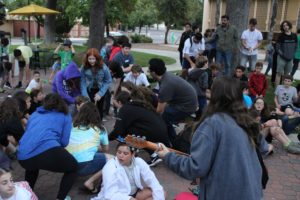By Eva Turner, Communications Manager and Songleader
Working at Sci-Tech West has been an incredible and unique experience. A camp that is dedicated to the innovative spirits and the scientific minds of children growing up as part of the reform movement is something truly special and can’t be found in any other space. Each day, the campers engage in hands on activities such as building robots, creating replicas of our veins and arteries, and designing companies to solve the world’s problems. After a long day of innovation and curiosity, the camp gathers for Erev Big Bang where we perform a big science experiment and reflect on the day we had at camp. Then, the campers go to Shira, or song session.
 I have always viewed music as an important part of Jewish heritage. Our psalms, teachings, prayers, and stories are all past down L’dor V’dor, from generation to generation. Music is one more way that our campers can connect to each other and with specific songs they relate to their camp experience. Knowing that our music is an important connection to our Jewish culture and heritage, I took it upon myself to teach music to our campers in the way that would best peak their interests.
I have always viewed music as an important part of Jewish heritage. Our psalms, teachings, prayers, and stories are all past down L’dor V’dor, from generation to generation. Music is one more way that our campers can connect to each other and with specific songs they relate to their camp experience. Knowing that our music is an important connection to our Jewish culture and heritage, I took it upon myself to teach music to our campers in the way that would best peak their interests.
Jewish music is the bridge between our heritage, traditions, and scientific curiosity. We strive to create Jewish literacy as well as fun and song during Shira. Music, much like science, utilizes theories and formulas to create an innovative and expressive final product. Adding and subtracting notes to a grouping of notes creates a chord in music theory. The addition of and subtraction of specific notes changes the entire equation of that specific chord to sound major or minor, happy or sad, to match the song or to add a transition. Once some of our campers understood the scientific intricacies music required, I found them more engaged in shira every night. 
As the songleader this summer, I got the opportunity to figure out ways to teach music to children who typically engage better in hands on experiments and experiences rather than auditory learning. After trying different methods, from sitting in a circle to “repeat-after-me”, I have had most success with song session engagement by teaching kids hand motions that connect to what the song is about. When these hands-on learners can physically engage in music through dance and motion, they retain the music better. I have also found that engaging kids before and after shira in conversations about the science behind how music works and the theory behind it has been extremely successful.
Sci-Tech is a place that let’s us experiment with our Judaism and the “traditional” way of doing things at camp. By incorporating hand motions and catering to our campers’ needs, I can share my love of Jewish music and help build connections between our Judaism and our love of science.
